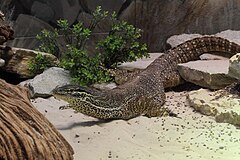Argus monitor
| Argus monitor | |
|---|---|
 |
|
| Varanus panoptes at the Cincinnati Zoo | |
| Scientific classification | |
| Kingdom: | Animalia |
| Phylum: | Chordata |
| Class: | Reptilia |
| Order: | Squamata |
| Suborder: | Lacertilia |
| Family: | Varanidae |
| Genus: | Varanus |
| Subgenus: | Varanus |
| Species: | V. panoptes |
| Binomial name | |
|
Varanus panoptes (Storr, 1980) |
|
The Argus monitor (Varanus panoptes) is a monitor lizard found in northern regions of Australia and southern New Guinea. It is also commonly known as the yellow-spotted monitor.
There are at least two Australian subspecies: the one in Western Australia is Varanus panoptes rubidus (rubidus referring to its reddish coloration), while the subspecies from Arnhem Land, the Kimberley and Cape York Peninsula is Varanus panoptes panoptes. The New Guinea variety is Varanus panoptes horni.
The size of an Argus monitor differs greatly between the sexes, with the female reaching an average total length of three feet (90 cm), while the male reaches an average of 4–5 feet (120–140 cm), the larger sized animals being V. panoptes panoptes vs. V. panoptes horni. It is a reasonably lean monitor and does not put on the bulk that its African cousins often do. Most Argus monitors are yellow in color, with a background of brown or dark tan. Their color often varies with place of origin or even the individual.
The Argus monitor is a versatile predator and inhabits a large variety of biomes and habitats. They are primarily terrestrial, meaning they spend a great deal of time on the ground. This species is an avid digger and will dig large burrows or take over an already existing burrow, where they spend a sizable portion of their time. Despite this, they will eagerly forage in trees and in the water. These large lizards are quite fast and will run up to 100 yards/meters to the nearest tree or burrow when they are chased. The Argus monitor is riparian in habits and as such, it can usually be found around a permanent source of water. The Argus will often "tripod" in captivity and in the wild, raising up on their hind legs and supporting themselves with the tail. This unusual behavior is used to spot potential prey or enemies from a distance or when they are threatened. They exhibit this behavior regularly in captivity. This habit provides them a unique characteristic that separates them from most other monitors.
...
Wikipedia
